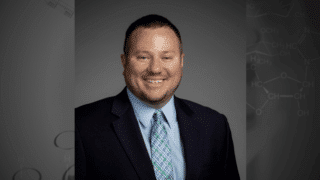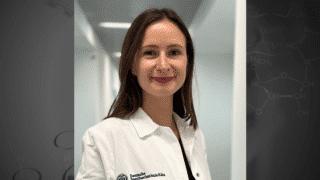In 2016 the PCC teamed up with Sensabues and Prof. Mario Thevis, Head of the Cologne anti-doping laboratory, to breathe new life into in-competition collection methods. We interviewed Prof. Thevis to find out how his scientific curiosity led to the development of a potential game-changer for sports anti-doping (and we promise there are no more puns).
(This interview also appears in issue 6 of the PCC newsletter).
How did you become involved with the exhaled breath project?
I was contacted by SensAbues, who has been developing prototype exhaled breath (EB) sample collection devices that have been used in other fields of research (mostly toxicology) before. The data available were interesting but I have to admit that I was skeptical in the beginning as to the benefit of EB sampling in doping controls over currently available conventional matrices such as urine and blood as well as other alternative matrices (e.g. dried blood spots, dried plasma spots, oral fluid). Fortunately, curiosity won and more literature research and more scientific discussions followed, which eventually led to the first studies on EB sampling as a potential tool in doping controls.
Why was the PCC a good partner for this research?
PCC has been open to the idea of alternative test matrices already in the past, especially when these matrices have suggested the potential to lower the athletes’ burden of doping control procedures while aspects critical to the drug testing programs are maintained. If the intrusiveness and invasiveness of doping controls can be reduced or even eliminated while relevant drugs remain detectable with adequate detection windows for the respective clientele, then the idea of exploiting new options of sample collection and analysis are most welcome.
Why is now the right time for exhaled breath in anti-doping?
A major limitation of EB sampling has been the collection procedure and the minute amounts of drugs made available from EB. This has required advanced collection device developments and analytical approaches of utmost instrumental sensitivity, both of which are now available. There is still need to further fine-tune and optimize the entire process, but all tools are at hand and the utility of EB testing should therefore be assessed as soon as possible.
How will this sample collection method solve some of the challenges leagues/sports are experiencing?
Due to the lack of any invasive or intrusive aspect of EB sampling, the obstacles of e.g. blood or urine collection requiring venipuncture or visual control do not exist. This allows a procedure much more convenient for the tested athletes and offers also substantial advantages, e.g. when the necessity of doping controls is introduced to minors.
What challenges needed to be overcome before the technology was ready for an anti-doping context?
EB testing is a comparably recent development and a number of questions need to be answered. For instance, little is known about interindividual differences in eliminating drugs via EB, i.e. is there an influence of smoking on the presence of drugs in EB or do athletes of different sports or sex eliminate drugs differently. Further, detection windows need to be tested at least for a representative subset of compounds to allow for estimating the utility of EB for the various different doping agents prohibited either at all times or in-competition only. [PCC note: studies involving interindividual differences and detection windows are in process].
Can you give us an overview of how the breath kits will be analyzed for PEDs?
The methodology that we currently use is particularly straightforward. The collection device can either be extracted as a whole or, after opening the plastic housing, the employed electret membrane is recovered and extracted. The organic solvent used for the extraction is then concentrated, and the resulting volume is either analyzed immediately for target substances such as simulants, narcotics, corticoids, etc. or further derivatization steps are conducted prior to chromatographic-mass spectrometric analyses. These analyses are very similar to those applied to conventional doping control matrices, which simplifies the implementation of EB into routine doping controls substantially.
How difficult will it be for WADA labs to implement analysis for EB testing?
Analytically, EB tests will not be a major challenge for WADA-accredited laboratories. All laboratories are equipped with the required instrumentation; it might however need dedicated testing methods, personnel and instrument time, but that would apply to additional blood or urine samples as well.
Who should be excited about this new technology?
There are a number of advantages that EB offers to athletes but also to the organization requesting the doping analysis. Samples are quickly collected and, according to current knowledge, stable during shipping and storage without the need for cooled transport. This needs to be verified in more detail but if confirmed, costs associated with the collection can be reduced compared to blood and urine testing. Testing menus might necessitate tailoring for specific sports, but that can be done on the laboratory level.
ABOUT MARIO: A forensic chemist, Prof. Thevis has been funded nine times by the PCC since 2009, most recently for his work with exhaled breath, but also for important work on growth hormone and meldonium. Currently head of the Centre for Preventative Doping Research, Prof. Thevis is also vice president for research at the German Sport University Cologne, Editor-in-Chief of Drug Testing and Analysis, a World Anti-Doping Agency (WADA) Prohibited List consultant, and one of the world’s leading doping experts.
FIELD TRIALS: Once the PCC received confirmation from Prof. Thevis that exhaled breath technology was viable within an anti-doping context, field trials were arranged to assess how the new collection methodology worked in a real-world environment.
Completed in early October, 2018, the field trials involved the collection of more than 500 (anonymous) samples from Minor League Baseball Players.
The samples are currently being analyzed against controls by Dr. Daniel Eichner at the SMRTL laboratory in Utah, and we should have exciting news to share with you soon.
We would like to thank the following partners for making the field trials possible:
CDT, MLB, USADA. SMRTL, and SensAbues.
Learn more about PCC Field Trials:
FIELD TRIALS: WHY
FIELD TRIALS: HOW




